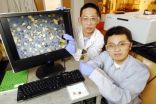(Press-News.org) LIVERMORE, Calif. – Beta cells, which make insulin in the human body, do not replicate after the age of 30, indicating that clinicians may be closer to better treating diabetes.
Type 1 diabetes is caused by a loss of beta cells by auto-immunity while type 2 is due to a relative insufficiency of beta cells. Whether beta cells replicate after birth has remained an open issue, and is critically important for designing therapies for diabetes.
By using radioactive carbon-14 produced by above-ground nuclear testing in the 1950s and '60s, researchers have determined that the number of beta cells remains static after age 30.
Lawrence Livermore National Laboratory scientist Bruce Buchholz, with collaborators from the National Institutes of Health, used two methods to examine adult human beta cell turnover and longevity.
Using LLNL's Center for Accelerator Mass Spectrometry, Buchholz measured the amount of carbon 14 in DNA in beta cells and discovered that after age 30, the body does not create any new beta cells, thus decreasing the capacity to produce insulin as a person ages.
Carbon 14 atmospheric concentration levels remained relatively stable until the Cold War, when above-ground nuclear bomb tests caused a sharp increase, or peak, which decreased slowly after the end of above-ground testing in 1963. This spike in carbon 14 in the atmosphere serves as a chronometer of the past 57 years.
Because DNA is stable after a cell has gone through its last cell division, the concentration of carbon 14 in DNA serves as a date mark for when a cell was born and can be used to date cells in humans
"We found that beta cells turnover up to about age 30 and there they remain throughout life," Buchholz said. "The findings have implications for both type 1 and type 2 diabetes."
Type 1 diabetes is an auto-immune disease in which the body attacks beta cells. Both genetic predisposition and environmental triggers that are poorly understood have been implicated in the disease development. Disease onset is frequent during childhood but can occur throughout life and requires lifelong insulin injections/pump delivery. The body simply lacks the ability to make insulin. Type 2 diabetes (often called adult onset diabetes) is common in older people whose ability to secrete sufficient insulin to regulate blood sugar deteriorates as they age and is often due to increased demand in obese people.
"It could be due to loss of beta cells with age," Buchholz said. "The body doesn't make new ones in adulthood and there might not be enough cells to control blood sugar."
In addition, as the obesity rate increases, the incidence of type 2 diabetes increases and it is now starting to be found in obese children.
Buchholz said there is active research in stem cell therapies to replace lost beta cells for both types of diabetes. "But with these new findings, it isn't clear how easy it will be to get the body to make more beta cells in adulthood, when it is not a natural process," he said. "At the surface, it seems like coaxing the body to do what it does naturally will be easier to accomplish."
INFORMATION:
The research was funded by the National Institute of Diabetes, Digestive and Kidney Diseases at the National Institutes of Health (NIH) and NIH/National Center for Research Resources. It appears in the October issue of the journal, The Journal of Clinical and Endocrinology & Metabolism.
Insulin-creating cell research may lead to better diabetes treatment
2010-10-29
ELSE PRESS RELEASES FROM THIS DATE:
Organic solvent system may improve catalyst recycling and create new nanomedicine uses
2010-10-29
Noble metals such as platinum and palladium are becoming increasingly important because of growth in environmentally friendly applications such as fuel cells and pollution control catalysts. But the world has limited quantities of these materials, meaning manufacturers will have to rely on efficient recycling processes to help meet the demand.
Existing recycling processes use a combination of two inorganic acids known as "aqua regia" to dissolve noble metals, a class of materials that includes platinum, palladium, gold and silver. But because the metals are often dissolved ...
A recent IRCM breakthrough impacts cancer research
2010-10-29
Montreal, October 28, 2010 – A team of scientists at the Institut de recherches cliniques de Montréal (IRCM) led by Dr. Jean-François Côté, Director of the Cytoskeletal Organization and Cell Migration research unit, identified a novel molecular mechanism in the control of cell motility. Their findings were published online today in Current Biology, a journal from the Cell Press group. This scientific breakthrough could eventually lead to the development of new cancer-treating drugs that could block the spread of tumours (metastasis).
"As many as 90% of cancer patient ...
Spacecraft will enable scientists to study space environment around moon, Earth
2010-10-29
Two spacecraft are now beginning to study the moon's environment as part of NASA's ARTEMIS mission, whose principal investigator is Vassilis Angelopoulos, a UCLA professor of Earth and space sciences.
One of these satellites has been in the lunar environment since Aug. 25, and the second arrived Oct. 22, marking the start of the ARTEMIS mission to gather new scientific data in the sun-Earth-moon environment.
ARTEMIS is an acronym for Acceleration, Reconnection, Turbulence and Electrodynamics of the Moon's Interaction with the Sun.
For roughly six months, the ...
Immigrant Latinos in rural Illinois have unique child care needs
2010-10-29
URBANA – Finding good child care and being able to engage easily in important interactions with your child care provider are critical to any mother's ability to work outside the home.
"Suppose you're living in the rural Midwest and you don't speak English very well. Can you imagine leaving your child with a child care provider if you couldn't communicate well with that person?" said Angela Wiley, a University of Illinois associate professor of applied family studies.
"The immigrant moms we interviewed for this study faced just this dilemma," she said.
Immigrant Latino ...
Newly discovered regulatory mechanism essential for embryo development and may contribute to cancer
2010-10-29
Researchers from Mount Sinai School of Medicine have identified a mechanism controlling the function of a protein that binds to DNA during embryonic development and may function to prevent abnormal tumor growth. When the protein, TCF3, is modified by a small molecule called a phosphate, it no longer binds DNA, changing the way the protein signals during development. This discovery identifies a new diagnostic marker (phosphorylated TCF3) that may be associated with cancer and could represent a potential drug target. The results are published in the current issue of Developmental ...
UM researchers are studying child-mother interactions to design robots with social skills
2010-10-29
CORAL GABLES, FL (October 28, 2010)—To help unravel the mysteries of human cognitive development and reach new the frontiers in robotics, University of Miami (UM) developmental psychologists and computer scientists from the University of California in San Diego (UC San Diego) are studying infant-mother interactions and working to implement their findings in a baby robot capable of learning social skills.
The first phase of the project was studying face-to-face interactions between mother and child, to learn how predictable early communication is, and to understand what ...
Wild Scottish sheep could help explain differences in immunity
2010-10-29
Strong immunity may play a key role in determining long life, but may do so at the expense of reduced fertility, a Princeton University study has concluded.
An 11-year study of a population of wild sheep located on a remote island off the coast of Scotland that gauged the animals' susceptibility to infection may give new insight into why some people get sicker than others when exposed to the same illness.
The answer to this medical puzzle may lie in deep-rooted differences in how animals survive and reproduce in the wild, according to the study, which was led by Princeton ...
Phosphorus identified as the missing link in evolution of animals
2010-10-29
A University of Alberta geomicrobiologist and his PhD student are part of a research team that has identified phosphorus as the mystery ingredient that pushed oxygen levels in the oceans high enough to establish the first animals on Earth 750 million years ago.
By examining ancient-ocean sediments, Kurt Konhauser, student Stefan Lalonde and other colleagues discovered that as the last glacier to encircle Earth receded, leaving behind glacial debris containing phosphorus that washed into the oceans. Phosphorus is an essential nutrient that promoted the growth of cyanobacteria, ...
People with specific kind of lung cancer respond to new targeted treatment
2010-10-29
AURORA, Colo. (Oct. 28, 2010) - A study in the New England Journal of Medicine shows more than half of patients with a specific kind of lung cancer are responding positively to a treatment that targets the gene that drives their cancer.
The study shows 57 percent of patients with ALK-positive advanced non-small cell lung cancer responded partially or completely to a tablet called crizotinib, an investigational anaplastic lymphoma kinase (ALK) inhibitor. In some cases, the cancer becomes undetectable in body scans. The data is published in the October 28 issue of the ...
UNH's Fred Short adds seagrass data to major conservation study
2010-10-29
DURHAM, N.H. – A major new study that sounds a conservation alarm for the world's vertebrate species notes that the world's seagrass species are faring somewhat better, says a University of New Hampshire researcher who was a coauthor of the study.
Fred Short, UNH research professor of natural resources and director of the worldwide program SeagrassNet, was among the 174 scientists who contributed to "The Impact of Conservation on the Status of the World's Vertebrates," released online this week in the journal Science.
"Some areas, including New Hampshire, are experiencing ...

